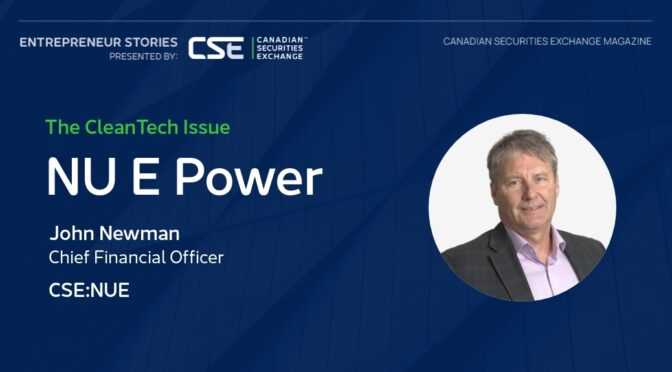While Europe gets much of the credit for leading the global push to adopt renewable energy, the United States and Canada are actually among the world’s top power producers from clean sources, thanks in large part to an abundant water supply for hydroelectric stations.
But solar and wind feature more prominently than most people probably realize, particularly on a total output basis in the United States. In both countries, multiple forms of renewable energy play a role in shaping the supply profile for regional power grids.
The stage is thus set for viable new renewable projects to help North America meet its increasing need for electricity, and NU E Power (CSE:NUE) is playing a role with an early focus on solar opportunities in Alberta.
NU E Chief Financial Officer John Newman spoke with Canadian Securities Exchange Magazine in mid-September about Canada’s renewable energy market, the company’s business model and near-term plans for growth.
Let’s begin with a look at why NU E Power was first established.
NU E was founded in 2021 by Devon Sandford, an electrician who specializes in the construction of utility-scale solar facilities and is also an entrepreneur. His vision was to develop a solar-to-hydrogen model, which was the initial business plan of the company. Back when we were looking for the capital to develop these projects, we were introduced to Low Carbon out of the U.K. and were able to strike what I think is a very unique joint venture with them.
Can you tell us how the joint venture with Low Carbon Investment Management works?
NU E is responsible for sourcing and developing solar projects in North America. We source the projects, we move through the regulatory process to get approval, and Low Carbon is responsible for funding all of the construction and development costs.
Once it gets to the investment decision date, we undertake a third-party valuation and the development is sold by the joint venture to a specific special purpose vehicle (SPV) set up for the purpose of constructing and operating the solar farm.
At the end of the day, NU E ends up with a 25% share of each SPV. So, for us, it’s basically a free carry on 25% interest in the solar farm. It’s a very unique situation and that’s something we want investors to understand – that this is really a very attractive venture for us as a company.
How long does the process take from beginning to end?
It’s a fairly lengthy regulatory process; from start to finish it can be 12 to 18 months. We source access points into the grid, we source available land, and then once we find suitable locations, we commence the regulatory process. We have a couple of developers on staff and Low Carbon pays 100% of their costs, as well as some of the management costs, and they basically pay 50% of our general and administrative expenses, excluding any kind of public costs and things like that.
Tell us about the joint venture’s first project.
Lethbridge One is an 8.75 MWac (MWac denotes nameplate capacity for a solar power facility) project that should go live this month. The cash flow generated from this project will be used to pay down the financing costs, so in terms of cash flow directly to NU E, it is expected to be $10.4 million over the next two years, meaning 2025 and 2026. Essentially, we’re building asset value at this stage.
As we look to the future, we will see cash flow coming from the sale of developments from the joint venture to the specific operating vehicles that are set up to construct and operate solar farms.
What’s coming up after Lethbridge One?
We’ve got four other projects in the development pipeline, around 500 megawatts worth that are in various stages of regulatory approval. That pipeline is probably worth $750 million to $1 billion of investment into Canada before taking into account investment tax credits or other incentives that the government has put in place to encourage renewable energy development.
Lethbridge One is quite small, but it was good for both Low Carbon and NU E to embark on a project like this just to understand the process. I think we’ve got all of that stuff ironed out, and we’re looking to much larger projects.
Can you talk about the energy market in Canada, the appeal for investors and what levels of government support and subsidies there are?
Our primary focus in Canada is Alberta. We have probably the most sunshine per year of anywhere in the country, so it’s an ideal place for solar farm developments. The preference at this stage is to operate in Alberta because it’s a deregulated market too.
Once you go through the approval process you can access the grid. What I think makes the renewable energy space ultimately attractive for investors is that you’ve got a lot of support from the government, both federally and provincially, in the form of investment tax credits on capital expenditures on renewable projects. For example, if we’re spending $1 billion, we could see up to $300 million of investment tax credits, so it’s a significant impact on project economics.
Another incentive is that Canada is no different than other countries in imposing a carbon tax, which is currently around $80 a ton and I think rising to $170 a ton by 2030, so there’s a big incentive for people to utilize renewable energy.
And when it comes to energy pricing, Alberta is a deregulated market and the price does go up and down, so we look to try and put in place power purchase agreements where we can establish an economic price for our power, which helps with financing and all sorts of things surrounding project economics. We’re also looking at the possibility of putting in place battery storage, so you can store energy and then release it into the grid when the prices are right.
Having gone through the regulatory process once, what’s the expected timeline for the rest of the pipeline?
Alberta went through a bit of a moratorium on approving new power projects that started last year and ended earlier this year. That’s delayed the approval process and seen some new rules around renewable energy put in place. So, it has impacted the timing to some extent, but I believe in the next 12 to 18 months that we will have approval on certainly the next two projects, Lethbridge Two and Lethbridge Three, which is around 150 megawatts of solar.
Does working with a U.K. renewable energy company set you apart in Canada?
Low Carbon is a significant player in the renewable market in the U.K. and Europe, so it gives us credibility that they’ve chosen to work with us and are prepared to operate the joint venture under the terms we have, which I think are very favourable to us. And I think it’s positive not only that we have a funding partner but also that they’re a well-recognized player in the renewable sector.
Is there opportunity for NU E to expand outside of the Low Carbon deal?
The joint venture is fairly well defined, and if there are projects that we bring to the table that they’re not interested in then we have the ability to pursue those opportunities ourselves.
We do have a couple of opportunities that we’re working on outside of the Low Carbon deal. The original business plan behind NU E was the production of green hydrogen through solar energy and that remains one of our key targets. We’ve actually just acquired 49% of Diloo Energy, a majority Indigenous-owned and -operated green hydrogen developer in Canada. We need to look as well at opportunities that will generate cash flow in the nearer term.
This story was featured in Canadian Securities Exchange Magazine.
Learn more about NU E Power https://www.nu-ecorp.com/.


